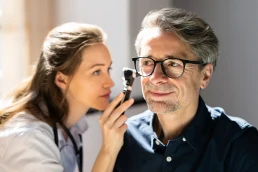
Frequently asked questions
FrequentlyAskedQuestions
Your questions answered
Which is the best method for ear wax removal?
Microsuction is the quickest and safest method as it avoids chances of touching the sensitive skin of your ear canal or any contact with the ear drum ensuring wax removal comfortably with very minimal risk of any further complications.
When do i need to consult an doctor for ear wax removal?
The common symptoms of wax build up includes itching in the ears, discomfort, ear pain, tinnitus or buzzing in the ears, feeling of reduced hearing, blocking sensation and infections. So it is advised to talk with a hearcare professional and get an appointment fixed if you have any of these symptoms.
Are there any side effects for ear wax removal?
Microsuction is a very safe method and side effects from it are rare but sometimes it may cause temporary side effects like feeling dizzy or faint, damage to the ear drum, noise induced damage or infections. These are very unusual complications and your audiologist or the healthcare professional dealing with the procedure are experienced and qualified to minimize or manage any side effects that may cause.
How are my hearing aids affected by wax?
Impacted wax can cause temporary or sometimes permanent damage to your hearing aids or you may need to clean your hearing aids more frequently to ensure it is functioning properly. It can also cause discomfort or poor fitting of your hearing aids as well as can cause your hearing aid to make a whistling sound.
Is ear wax removal at home safe?
It is not recommended to use any kind of objects such as cotton buds in the ears to remove wax as it further pushes the wax away and can cause build up rather than removing it. This can also cause damage to your ear drum and can even lead to infections and hence ear wax removal at home is not safe and should be left with the professionals.
What should i do before coming for an ear wax removal appointment?
Your audiologist might ask you to ask to use olive oil drops which naturally softens your ear wax before you appointment based on your history. These are not advised if you have a history of ear infections or if your ear drum is perforated so it’s best to get an advice from a professional and to follow their guidance about it’s use and dosage before your appointment.
Are Hopi Ear Candles safe?
The ears and eyes are the most delicate parts of the human body exposed to the elements. It’s worth putting in a word in about Hopi Ear Candles. This a dangerous procedure carried out mainly in the USA as they do not offer a free healthcare service. Unfortunately General Practices stopped offering ear wax services in the UK in Sept 2021 so patients are now exploring their options. Since 1996 The FDA. The food and drug administration has taken action against companies promoting this. www.entnet.org. The MHRA, the United Kingdom’s regulatory authority will follow suit if these products continue to be promoted in the UK. They are not safe. They are dangerous and they are ineffective.


We are committed to exceptional service at a time that suits you. We offer appointments 7 days a week
Ear MicrosuctionFrom £50 for 1 earand £65 for 2 ears
Ear microsuction is where the ear wax is gently removed via a small suction device.
Ear IrrigationFrom £50 for 1 earand £65 for 2 ears
Ear irrigation is where controlled low pressure water flows into the ear until the wax is removed.
Very professional team, the GP and audiologist that saw me were really nice and personal. I booked to have 2 ears checked and when they discovered I only needed 1 tbey refunded me rather than taking the money and seem as if they were doing both. If and when the need arises I will 100% be back.A Degnan
This was my first visit to the clinic at Waverley House. I received a warm welcome and made to feel at ease. The procedure was simple but efficient. The doctor took his time and explained everything to me. I had paid in advance for both ears to be cleaned but he informed me after examination that one ear was clear. I have received a £20 refund. The second ear was filthy and all wax removed. I received first class service.H Speedie
Service was 10/10. Easy to book the appointment. Very friendly on arrival and all the way through the service. Made me feel very comfortable. Work carried out was great too. I could barely hear going in and feeling very frustrated. I left very happy and able to hear out of both ears again with my hearing very clear and open. Would recommend and I will definitely go back myself.P Cunningham
